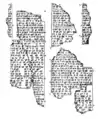Sargon II's Prisms
Sargon II's Prisms are two Assyrian tablet inscriptions describing Sargon II's (722 to 705 BC) campaigns, discovered in Nineveh in the Library of Ashurbanipal. The Prisms today are in the British Museum.[1]
| Sargon II's Prism A | |
|---|---|
| Material | Clay |
| Size | 6.4 x 4.4 cm |
| Writing | Akkadian cuneiform |
| Created | c.710 BC |
| Discovered | Mid 19th century. Combined identification in [1903] |
| Present location | British Museum |
An excerpt of the text as translated by Luckenbill as below:
"... Philistia, Judah, Edom, Moab ...".
Known fragments
Prism A
- K. 1668b + DT6: four columns, with 15, 42, 48 and 19 lines[2]
.png.webp) Diagram for the reconstruction of Prism A
Diagram for the reconstruction of Prism A Prism A fragments
Prism A fragments
See also
External links
- The Prism in the British Museum
- The Assyrian Eponym Canon, George Smith, 1875, page 129
- Catalogue of the cuneiform tablets https://archive.org/details/catalogueofcunei00brituoft
- "Full text of "Die keilschrifttexte Sargons"". Retrieved 2015-11-15.
- http://www.isaiah666.com/sargon_annals.pdf Palestine
- "Babylonian and Assyrian Historical Texts" (PDF). 4 September 2006. pp. 287–288. Retrieved 2015-11-15.
- Mazar, A.; Mathias, G.; Studies, I.J. (2001). Studies in the Archaeology of the Iron Age in Israel and Jordan. Bloomsbury Academic. p. 260. ISBN 9781841272030. Retrieved 2015-11-15.
References
- "Full text of "Assyrian historiography, a source study"". Retrieved 2015-11-15.
- Catalogue of the cuneiform tablets in the Kouyunjik collection of the British museum, p.327-9
- Catalogue of the cuneiform tablets in the Kouyunjik collection of the British museum, p.328, Fragment of a terra-cotta prismoid, 7 3/4 in. high, one side 2 7/16 in. Parts of two columns, with 64, 63 lines respectively, with very neat and clearly written, but partly mutilated and defaced Assyrian characters. The lines of Column I are more or less mutilated at their beginnings, and those of Column II are mutilated at their ends almost throughout. Remains of an inscription of Sargon II. [K. 1668 a + K. 1671]
This article is issued from Wikipedia. The text is licensed under Creative Commons - Attribution - Sharealike. Additional terms may apply for the media files.
